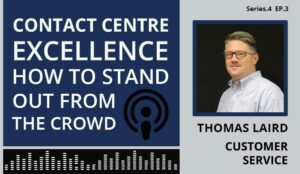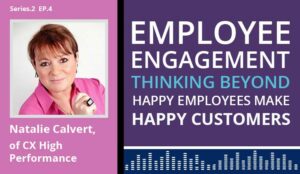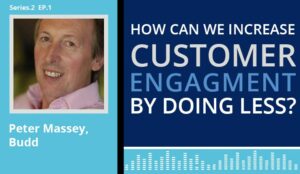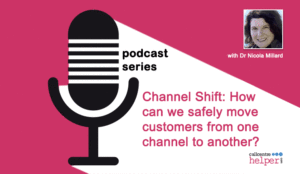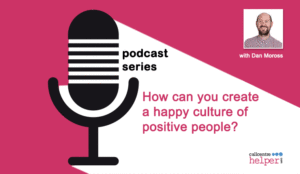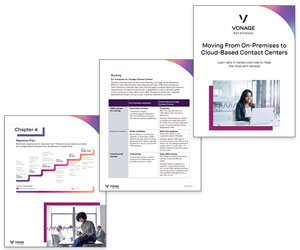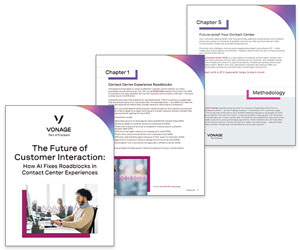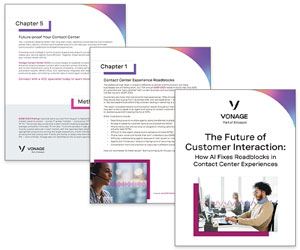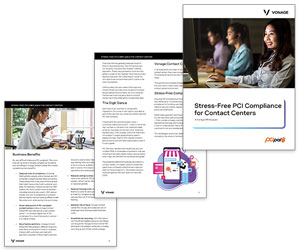The Contact Centre Podcast: Series 4 Episode 3
Thomas Laird, host of the podcast “Advice from a Call Centre Geek”, discusses the traits of an excellent contact centre and how you can stand out from the crowd.

In our conversation, we also talk about how to improve contact centre culture, share tips to create a unique customer experience and give examples of how leading organizations are excelling at customer service.
To listen to the podcast directly from this web page, just hit the play button below:
The Contact Centre Podcast – Episode 21:
Contact Centre Excellence: How To Stand Out From The Crowd
This podcast was made possible by our sponsor Vonage.
Podcast Time Stamps
- 1:21 – Traits of an Excellent Call Centre
- 6:04 – Improving Culture
- 9:33 – Technologies That Can Help You
- 15:22 – Examples of Call Centre Excellence
- 19:57 – Differentiating Your Service
Here is a Transcript to the Podcast
Charlie Mitchell: So I’m going to start today’s podcast by asking a very broad question and that is what are a few of the key traits of a really excellent contact centre?
Thomas Laird: Charlie, I’ll give you five. There’s five things that I think we look for when we see a high-producing call centre and something in my call centre that we really try to stress. And some of them might be self-explanatory but others might be a little bit, I don’t want to say off the wall, but a little unique. But number one is really measuring the proper metrics. Well, we are all and our industry as a whole is so stuck in service level, average handle time, ASA, talk time. And when we hit these metrics, so you know I have an 80/30 today with an average handle time under four minutes, so I had a great day. Well, the problem with that is the only thing that you’re measuring is the efficiency of your call centre and the efficiency of your reps. But you’re not listening to the customer experience at all.
So a high-producing contact centre, and I think one of the great contact centres now is starting to listen to the customer. That started with C-SAT and NPS scoring, but I think we can take that to the next level and really get into the speech analytics and looking at customer sentiment scores. So if you can benchmark a customer sentiment score and you’re raising those scores, plus having the efficiency of your call centre be… you know when you’re hitting those service levels, you’re hitting those telephony metrics. I think that’s kind of the new definition of a world-class centre and something that really you can benchmark from.
The other thing that we see kind of stresses in that education format, where your middle management run your call centre. If you have really strong supervisors, really strong team leads, you’re going to have a strong call centre. So making sure that you have a management training programme. Making sure you have ongoing education, not just for your reps but for your management. That you’re not just pulling a high-producing rep off the phones and putting them into a supervisory role, I think is really important.
Number three, and I know I’d like to talk about this a little bit more as we go on here, but number three is can you define your culture? And everybody talks about, hey, improving the culture. But nobody really knows what that means. So when you can define your culture and then you have the ability to hire, promote and incent off of that culture, it totally changes what your contact centre can be, from just saying, “Hey, I think this person’s really good. They’ve been in the contact industry for a long time.” That’s a really important part. And I know… I think we’re going to touch on that a little bit later.
Number four is it’s got to be fun, right? I mean the contact centre, and you can do things that you can’t do anywhere else. From having games going on constantly in the call centre to having something that the reps are getting up and out of their seat, I think is a really important thing. When you’re really looking at that occupancy number and dialling it down a little bit for a game or something in the call centre is important.
And the last one I have that I think is really important too is we do a very poor job as an industry as a whole with educating tone. When we educate, we educate where to click in the CRM and when a customer says this, you’re going to go to this and you’re telling this. But we don’t do a great job of actually using the tone of their voice. What words are we using? How are we saying it? Because my saying with my call centre is “the tone is the message”. And if your tone is poor, no matter what the experience or the message, and even if the customer gets what they want, if that tone was wrong, the experience was poor. So I think those are our five really core key metrics and things that people can strive to have a unique and a cool call centre.
Charlie: Yeah. I think there’s so many interesting things there. One of those especially that I really liked was defining your culture, and that’s something that I’m very keen to get back to in a little bit as well. Another couple there that I would also add in, and I’m sure you’ll agree with as well, is having close links to other departments, as many excellent contact centres often use journey maps as business tools. And it’s a way of improving collaboration across the business. I think a big problem that we have with journey maps is that they’re often put together by third-party consultancies and that mindset carries through to the rest of the organization. And so we don’t see the benefit that maybe journey maps can have in the call centre. And another one that you did also touch on a little bit was having clear support systems for your advisors.
So instead of relying on scripts and processes and procedures to answer customer queries, maybe having a regularly updated knowledge base and other support systems like a Slack channel that’s managed by senior agents. I think that can be a very nice idea to ensure advisors can make the best decisions with customers as an individual. So I think lots of really great stuff there. And I think that these support systems are often symptomatic of a great contact centre culture. And excellence often comes from having a great contact centre environment. So I was just wondering, I think one of the key questions that I wanted to ask you is: what are the most niche things that you’ve seen contact centres do to improve their culture?
Thomas: Well, the first thing is, and I think that this is really important, is again, as I just said earlier, is… We all talk about improving culture, but really nobody knows what that means. If we go to consult or if I talk to a client who has an internal call centre and I say, “Hey, I want to match the culture that you guys have if you really like it, and can you define that for me?” And everybody struggles with that. So the first thing is I think you need to define it. Let me give you an example. So in the call centre that I run here, our BPO, our culture is a sunshine attitude with an entrepreneurial mindset. Now that’s a lot of mumbo jumbo. That’s the pretty thing to put on the mission statement deal. But what that boils down to is attitude and effort.
So those are the two pillars that we have decided are going to be what we’re going to hire, what we’re going to incent and what we’re going to promote off of. So we have done things such as using agent sentiment scoring to actually incent reps to have a nice tone and actually pay them more for being nice on the phone. Like it’s a benchmark now that we can actually use. We can look at the effort piece of this and we actually pay our reps incentive on attendance. And that can actually get pretty significant if they can string a couple of weeks together of 100% attendance. The same thing goes when we go to hire, right? We’re not looking at a résumé. And I think that this is a big mistake that a lot of call centres make is… is HR will come to the call centre guy and say, “Hey, I think this person is going to be a great fit.”
My question, though, is a great fit for what? Right. So I think that that’s a really, really important piece is understanding what you want. Do you have a sales call centre where you’re looking for more individuals who are driven off of a monetary number? Are you looking for more customer service associates that can work in a team, are collaborative, have the proper tone? What type of individual do you want? And then once you can figure that out and HR can figure that out, then you can actually add pillars which is a lot of fun to promote, incent and hire off of those pieces of culture. So I think that there’s a lot of things that you can do then, once you decide this is the type of centre that we have. And the other thing that I see with call centres is that the company culture, so if you have an internal call centre, your call centre culture doesn’t have to really totally match the company culture, right?
Because you could be like at a very stoic financial services organization where everything is very professional. And not to say that your call centre is not going to do that. But the type of tone that you want to project from your brand might be different than what the finance guys are after. Those are a lot of questions that you have to ask from a culture standpoint of the company. And then drill down to the call centre and see what type of tone, what type of individual do you want to project for your brand.
Charlie: Yeah. Lots of great stuff there. And it goes back to the first point that you mentioned there of creating a great culture is getting your recruitment right. And it goes back to the old cliché, I think of hiring for the right attitudes instead of necessarily the right skills. I think there’s lots of great stuff that you built on top of that, but I just quickly want to change the focus to something else now. I think people, process and technology are the three things that we need overall to achieve contact centre excellence in terms of culture and beyond. So now focusing maybe on more of the technology angle because we haven’t discussed any of that so far. Which emerging technologies are contact centres now using to stand out from the crowd, in your experience?
Thomas: Well, a huge argument going on in the industry right now with how far is AI going to go and how quick is it going to happen, right? And I think anybody in our industry would be naive to think that it’s not going to play a significant role here in the next coming years. I don’t know if that’s five years, 10 years, six months. But I can’t say that with in November Google just released basically their call centre AI platform. So everybody can now quote/unquote I guess start playing with it. The first couple things that I think are going to have an impact and we are looking at this year is, number one is, real-time transcription in the Google Agent Assist. So how powerful of a tool this will be to have an associate really be sitting there, right, talking to a customer and I’m going to get a couple of things.
Number one, I’m going to get a real-time sentiment score. So currently we take sentiment from speech analytics in the aggregate and we look at it over maybe a day, an hour, two hours, three weeks. But now we’re going to be able to get it in real time. So we’re going to be able to have a supervisor, have a mission control or have a QA area. Really be able to see visually if a call’s going south, if a customer is irritated. I think that’s a really powerful tool from a QA standpoint and especially from a real-time QA standpoint. And then when you get the real-time transcription as well, and then AI being laid over that, so as words are being spoken from the customer standpoint, as words are being spoken from the agent’s standpoint, the key points of that call are going to be able to be pulled out.
And if a customer calls in and says, “Hey, I’m really interested in this product,” to actually have a PDF or information on sales data or the last specs on that product automatically pop up to an agent, so that they’re not looking and searching and talking about that. Same thing on the customer service side. Moving forward, that’s where it gets a little sketchy. We have… every day I get people talking to me like, “Hey, reduce 30% of your call centre agents with this AI,” because everybody saw that Google at their user conference, what, about six or eight months ago, and they called the hair salon and had a real human that wasn’t a human go through the whole process.
That’s not here yet. But again, I think we’re naive to think it’s not coming, but I think from the Google Agent Assist, real-time transcription, those things are here now. And they’re going to have a huge benefit in the customer experience for the customers and the clients and the companies that want to start to implement and move down the road with this AI technology.
Charlie: Yeah, I think there’s a couple of really interesting things then. My thought, especially your examples of sentiment and how that will be used further on the past… the examples of speech analytics systems is very interesting because we often hear customer emotion talked about as quite a promising concept. But it’s never really, really, yet being used widely in contact centres to achieve really accurate and outstanding results. And I think there’s a couple more technology examples that I would even add to that. I think passive voice biometric systems, so bypass complex ID&V processes. So these systems will, as the customer speaks, be able to verify whether it’s them or not based on characteristics of their voice.
Thomas: And hey, not to interrupt you, but we’re seeing that especially implemented with our financial services clients. So it seems like that’s the… one of the key channels that are really, really looking hard at that. Obviously security in those types of aspects are so important in that business model, that they’ve been really leaders in that space.
Charlie: Yeah, I think it’s always… Because for biometrics has always been a very good technology to use in the contact centre, but to have it without it being invasive for the customer experience I think it’s a very important step. And then again, another one is WFM technology and it’s giving advisors more control over their schedule and they can access a schedule through their phones as well using certain tools. And I think those are very promising technologies too. So AI is very important, as you say, and analytics and biometric systems. I also see WFM technology increasing its presence in the contact centre in the future.
Thomas: Let me add on too, that’s a really good point that you make. And we see from WFM as well – and it goes really to the core of routing – is really setting up and having AI move agents within skills, as maybe things go wrong or you start in a heavy queue. So instead of the panic happening of Janie supervisor, Janie in charge of the room, moving agents over, to really be able to see that, to see in the IVR that there’s a predicted wait time of this and to move agents ahead of time into different skills without human intervention too is something that that’s kind of been there, but it’s starting to get really good too with the influence of AI.
Charlie: Yeah. I think adding, maybe adding AI to real-time dashboards is something so that these resource planners who are monitoring calls as they’re coming in can better judge whether they need to go into their standard operating procedures and call out for backup if things go much [crosstalk 00:14:49] but then sometimes you’ll have a little peak in contact volumes and then you’re calling in the whole reinforcements. Then that’s only a temporary lapse. So it’s much better for your planners to have those dashboards with the AIs you were talking about, to really help them to not make those knee-jerk decisions and better use resources. I think there’s so many more that we could talk about, I’m sure. But just generally going back to this idea of contact centre excellence. I just wanted to pick your brain in terms of which brands really come to your mind when thinking about how to differentiate overall customer service and why.
Thomas: Yeah, and maybe I flipped this question around. But let me answer that and then add the, maybe the devil’s advocate to that. So you have different companies that have almost weaponized the customer experience, right? You have Zappos, you have here in the States, you have Chick-fil-A, right, that have… When you think of those companies, one of the first things that come to mind is the actual customer experience. And that’s an amazing thing. And how they’ve done that is it’s in every piece of their culture. It’s in every piece of social media that goes out. It’s in how they actually interact with customers. When I drive through a Chick-fil-A and I say, “Thank you,” they say, “My pleasure.” Those two little words that everybody is ingrained and trained with have made a huge difference and made people think about, how can I brand?
Because actually branding their customer experience, which is a really, really cool and opens up a whole new set of really cool and unique things that you can do from that standpoint. But working in a BPO and owning a BPO, so we’re an outsource that works with a lot of different clients. We come see the flip side of it with the companies that I don’t want to say are not doing it well, but it’s not a priority. So a lot of the big tech companies. So what happened? And this is a trickle-down effect. So you have the Facebook and the Google the LinkedIn and those big giant type of tech companies that if you want to try to get a hold of their customer support, you’re going to go through a process, right?
And you’re probably not going to get anything real time and it’s going to be an email. So what happens is we’re seeing a lot of start-ups that we’re working with that have the same exact mentality, right? They think that they can do what Facebook does and Google does because that’s who they interact with and who they mould themselves after. It’s such a poor way of doing business, and we’re trying to get them to see the light at the end of the tunnel and what a tool dealing with your customers is. But also how awesome it is for your business model, right, when you’re handling these guys in a first call resolution, trying to get them within a certain time period. Actually talking to them where you can do cross-sells and upsells after, you’re really handling and building brand and building a unique experience for them. So the companies that are doing it right or are killing it. It’s not easy. Right? And it’s a ton of training and it’s a company-wide process that needs to happen. But when you do it and it’s done right, it’s such an advantage for a company or for a brand.
Charlie: I think especially with start-ups, as you mentioned, because they don’t have many of these really old processes and procedures that can get in the way. They have more of an opportunity to really, as you say, make the most of the possibilities that are out there.
I think there’s lots of great stuff in what you said, and you mentioned Zappos specially and that made me think recently of Amazon, who obviously bought Zappos not that long ago. And they offer $2,000 to employees who’ve been at the company for one year and that increases by $1,000 every year of their tenure. So it maxes out at around $5,000. And those that accept the offer can never work at Amazon again. And the aim is to hire people who want to work for Amazon because they want them to stay somewhere where they want to work. And if you don’t want to work there it won’t be healthy for either the individual or the company, so they accept the money and go elsewhere.
I think it’s a very interesting concept. I’m not sure if it’s very practical for most brands out there—
Thomas: I know. Right, right, right.
Charlie: But I remember hearing that and thinking, well, that’s a really interesting idea. But it’s moving onto the next one again, I was just wondering what tips that you have for contact centres like that but for making their customer service experience a unique experience.
Thomas: Yeah. One of the things I want to add and I can maybe throw into this as well, but when we were talking about culture, that’s kind of we talked about the hiring. And that’s the defining the cultures, the macro, right? And then moving into the micro with that, which I think goes into your question here, the unique customer experiences. One of the things and one of the biggest tips that I can give to improve someone’s call centre and also I think make the customer experience better is, we call it controlling the first 30 minutes of the shift, right, or 30 minutes of the day.
So whatever your culture is, if we’d like to have music going, we like to have a high-energy call centre floor. And I understand you have different reps in at different times, but at the beginning of the day I think that’s really important. To have a every single associate greeted as they come in, right? So the email that you’re working on, Mrs Supervisor is not as important as that rep that’s coming in by you. So whether you’re a high-fiver, whether you’re just a handshake or whether you’re a Hey Janie, you know, taking the temperature of your rep I think is really important.
Then recapping the day before, giving goals out for today’s day. And then actually every single team that we have here at Expedia, there’s a game going on on every single team. Whether it’s team versus team, whether it’s individual versus individual, something’s going on. But I think if you can control that first 30 minutes, the customer experience improves vitally because you know that you’re kind of… You turned any of those poor attitudes that maybe came in. You’ve taken the temperature of the room. Everybody understands the goals and they understand how they’re going to have fun for the day as well.
So I think that’s really important. Some of the other things from a unique experience. We’ve touched on this a little bit about you’re really branding or immersing your customer into your culture. So if you are, again, a financial services organization, maybe you want to have “yes sir, no sir”. You’re immersing them into that professional attitude. But if you are a shoe company or you’re a retail and you’re working with 18-to-25 year-olds, maybe you can use words like, “Hey, that’s cool. Oh Hey, thank you. That’s awesome,” right? Not everything needs to be cookie cutter, and how you talk to your customers and how you brand your service I think needs to match the culture and what you’re trying to reflect. And that’s something that we try to do here a lot to every single client that’s a little bit different.
So to match the rep with how to speak to the customer, even demographic, those types of things I think are really important. The other really cool thing that we’ve had customers actually buy into is using customer experience as a marketing tool. So we actually are taking service level, we’re taking calls in queue, we’re taking agent and customer sentiment scores and we’re actually posting them on their website through APIs. So in real time, right when a customer goes to XYZ company’s customer service page because they need to talk to them when they need their phone number, they’re going to see the amount of calls in queue, the customer and agent sentiment scores, which hopefully are good, right? Those types of things. So if we’re doing our job here in the call centre, those stats from both a telephony efficiency standpoint and also from a customer sentiment standpoint should be really high.
We can actually prove to customers that they’re getting a really, really high-end customer service experience. And then we talked about some of these other things too of incenting the proper KPIs. Not just tracking them but actually paying your reps off of new types of technologies. The new sentiment scoring. I’m really looking at what makes a really cool customer experience. And it’s not just service level, it’s not just handle time. But looking at some of those metrics. And then lastly, every single call centre out here, and I think that this is really important is, we have so much technology, right? And not all of us use the technology that we have. And I think one of the really important things is, is to talk to your supervisors to really dig into whatever platform you have.
There’s tools that you’re not using that can improve and make that customer experience unique that you don’t even know you have because you’re just stuck in “this is what we do”. So every time that we go consult and we go talk, that’s one of the huge questions and it blows people’s mind. Like, “Oh my gosh, I don’t even need pay for this. We’re just not using it.” And I think that that’s a really important tip, to really dig in and… The platforms that are out there today are so powerful that there’s a lot of things that you’re probably not using that you probably should be.
Charlie: Yeah. I think that’s a very good point. And it was so many good points in there. And I really liked the first one of controlling that first 30 minutes of the advisor’s day. I think it’s a very interesting, it reminds me of when I went to Sky, who’s a UK network provider. Their contact centre and every… At the start of the first 15 minutes of every day they would have quizzes for everybody and that would include like how can you find this in the knowledge base? That quiz and refresher sessions for everything. And it’s a way to get high energy for the day and make everybody enthusiastic before they go on to calls. I think that was really interesting. And one other thing actually that I recently heard on your own podcast was something called, I hope I’m saying this right, the chicken filler effect? Sorry, sorry—
Thomas: No, that’s all right.
Charlie: I was just wondering if you could just tell us a bit more about that.
Thomas: Yeah. And that goes like to the… that’s the Chick-fil-A, right? So whether or not we go through that drive-thru, when we go through that experience, I know I’m going to get a good experience there. We have here in the States, and I’m in Pennsylvania, we have a… It’s one of our main streets here, it’s called Peach Street and there’s a Wendy’s, a McDonald’s, a Subway. There’s four or five different restaurants that are all in a row. And all those guys you can go through their drive-thru and be done in 30 seconds. You go through Chick-fil-A and you could be there for 20 minutes waiting to the drive-thru. And again, is their chicken that much better than everybody else’s? No. But what they’ve done is they branded it as such a high-quality establishment with high-quality service that people know that they’re going to get a really good experience. And even the food that they’re going to get has a certain level of quality.
Thomas: It’s no better than anybody else’s, but just the presentation of it, how it’s wrapped up is really important, and I think that’s what we do in the call centre. We are the voice of the brand that we’re working for. You’re the voice of the brand of your internal call centre. What are you trying to project to the customers? What type of culture, how are you talking to them? And if you get that right, right? And if you can get that to be trained and be stable across a multitude of agents, it really is a weaponization of customer experience, which I think is really important and can really drive your brand.
Charlie: Hmm. Excellent. I will not forget how to say Chick-fil-A.
Thomas: There we go. You got it.
Charlie: There we go. Improvement. You did say that earlier actually and I was like, I think that’s it. But excellent stuff, and we’ve talked about so many great things now and I know that you have your own podcast, so where can our listeners go if they want to hear more from you, Tom?
Thomas: Yeah. So listen, I believe that if you are looking for really for… And as we talk – I coach basketball as well here in the States. And no, if you’re looking for place like actual things to improve your call centre, like the tips of the first 30 minutes, the Call Centre Helper Podcast. And then my podcast, which is Advice from a Call Centre Geek. I think they’re the two best out there for that.
Thomas: We don’t really talk about theoretical experiences of the customer experience, but just really try to dig down into actual, helping actual call centre managers, supervisors. Try to give actionable items that you guys can take back and improve your call centre. And then just as a cheap plug as well, I do have, it’s on Amazon, I do have a book, it’s called More Advice from a Call Centre Geek. Keeping that brand going. It’s super cheap and it talks about a lot of the things that we’ve talked about here and goes into a little bit more detail to a lot of things that I think work really well in a call centre environment.
Charlie: Excellent, and I would very much recommend your podcast as well. It’s great for a quick morning drive to work. Just put on a 10-, 15-minute episode and it’s so perfect for that in my experience. But anyway, thanks for joining us today, Tom, and thanks for everything.
Thomas: Thank you so much. It was fun.
Author: Robyn Coppell
Published On: 20th Apr 2020 - Last modified: 26th Sep 2025
Read more about - Podcasts, Charlie Mitchell, Podcast, Thomas Laird, Vonage





